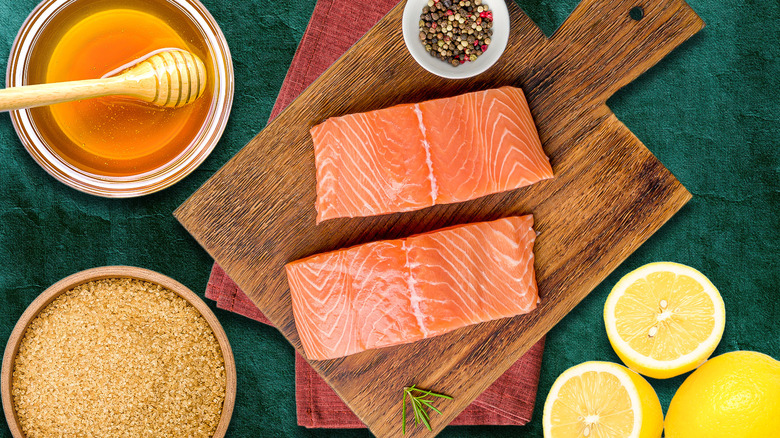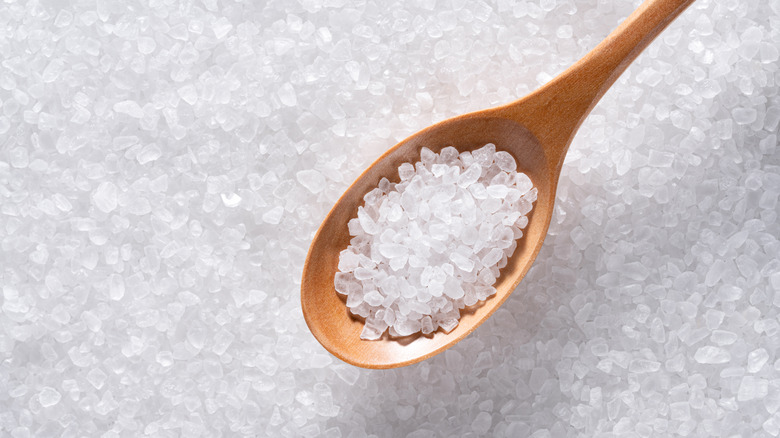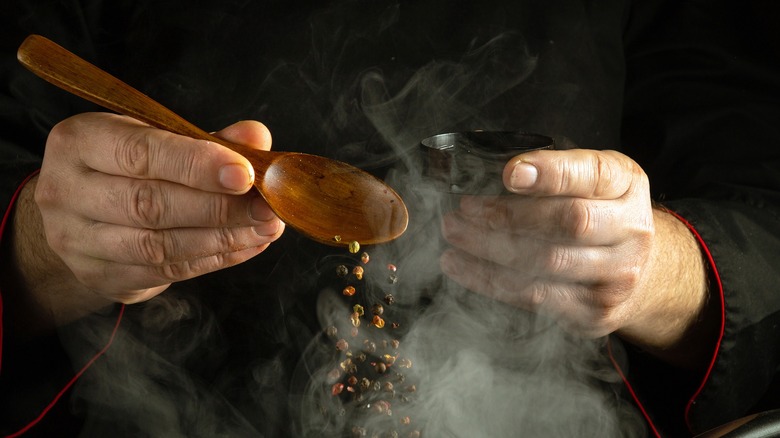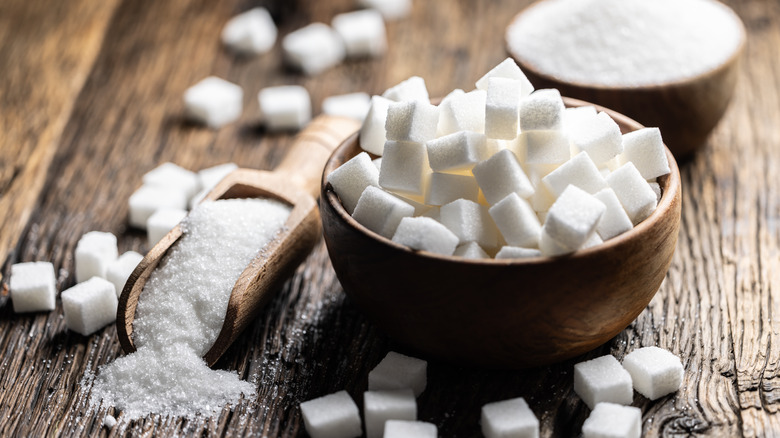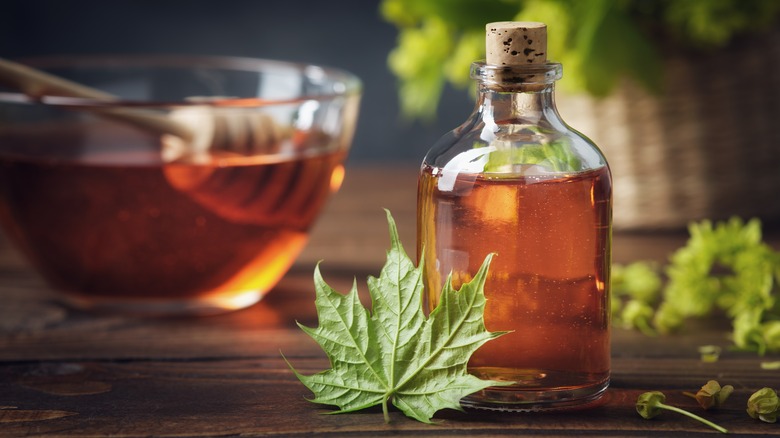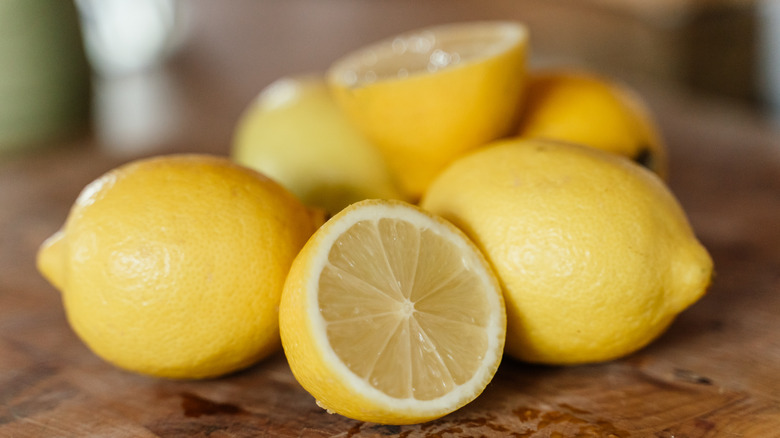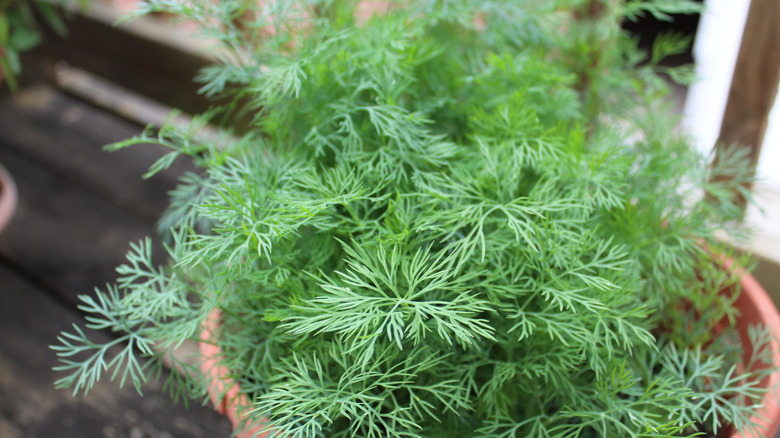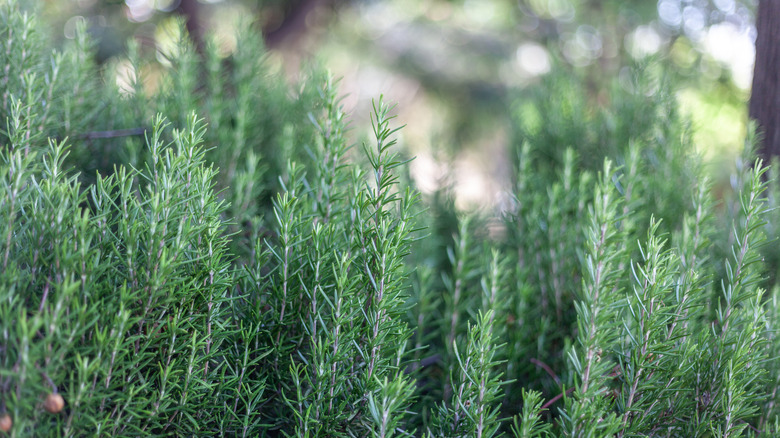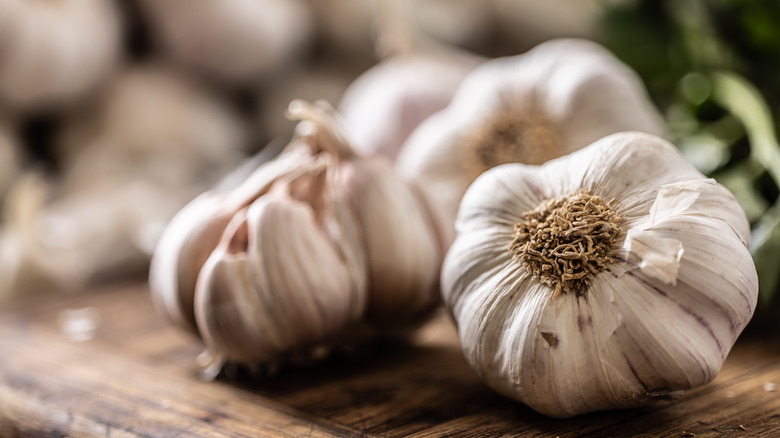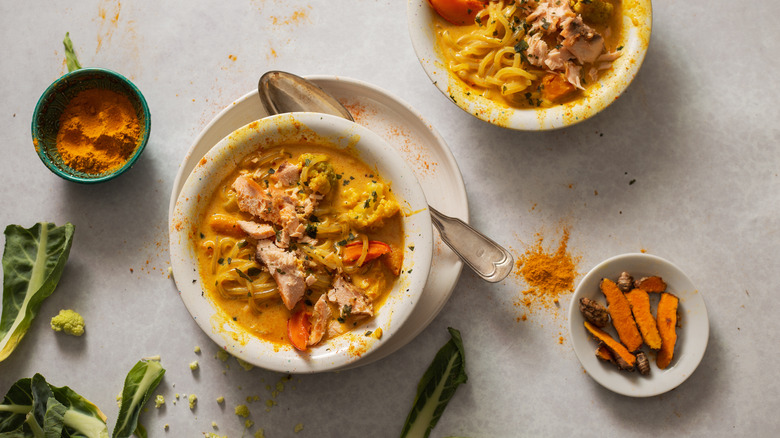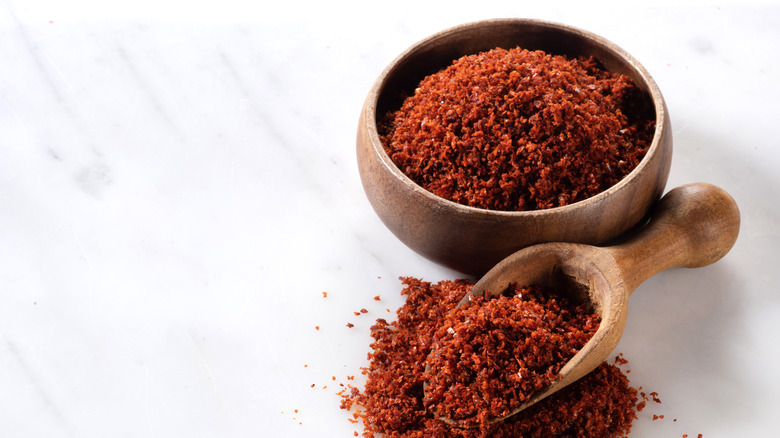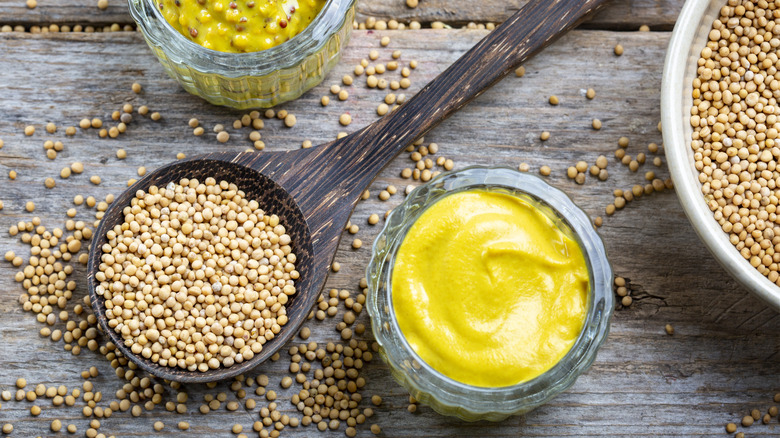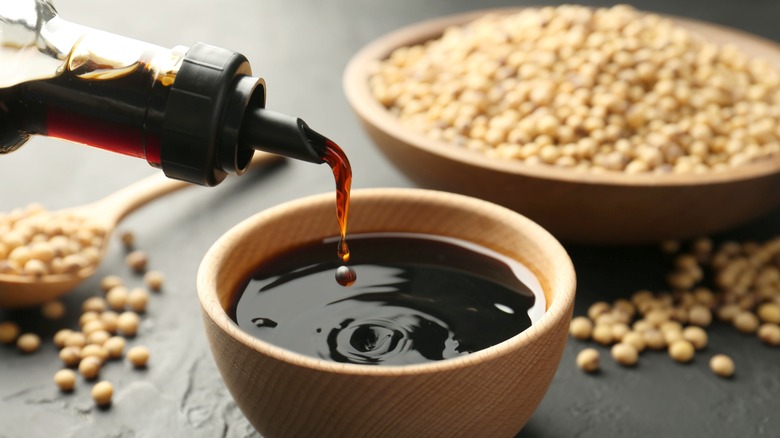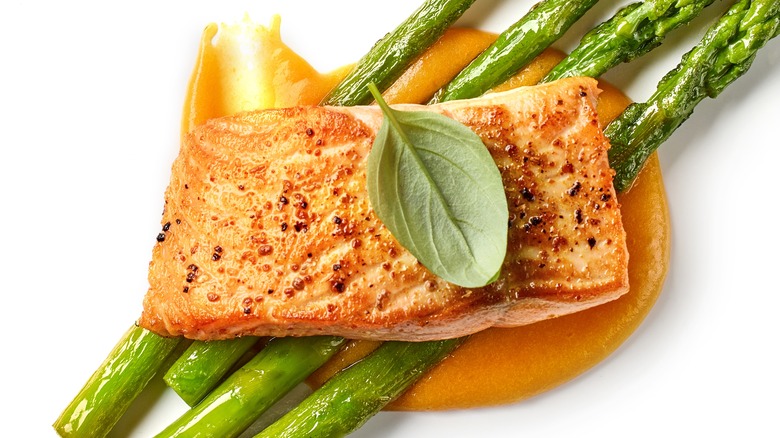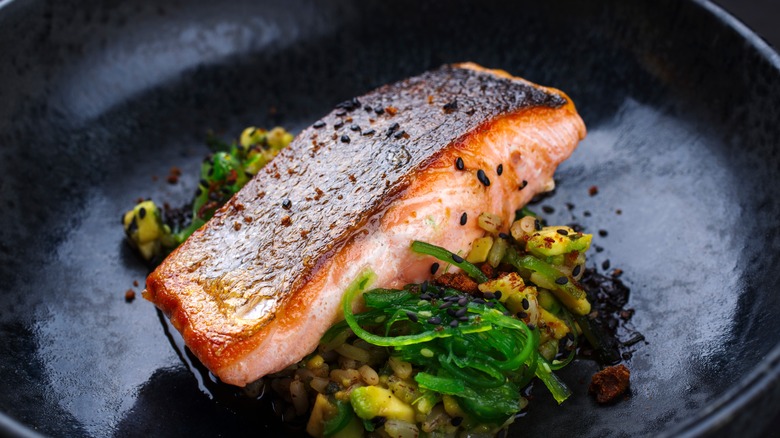14 Seasonings That Will Upgrade Your Salmon
As a Pacific Northwest native, I am, like all of us, gaga over salmon. Any grocery store worth its salt sells salmon ... usually five or six kinds, in fact. Since I was in high school and tasked by my mother with helping to cook for parties and weeknights (a chore I mostly had a good attitude about), I've had my hands in the salmon pot. (And yes, you can make salmon in a pot. You can also brine it, cure it, bake it, broil it, pan-sear it, and eat it raw.) Over the years, making salmon at least once a month and usually more, I've probably prepared it about 300 times, in every form from party puffs to chowder to all-out bagel boards.
If you already know how to cook salmon, huzzah! Your family and guests will thank you. However, there are always ways to take this beautifully-hued fish to the next level, and seasonings are an excellent place to start. Even better, many spices and herbs will make your fish healthier as well.
Where do you go wrong? Only by avoiding experimentation. Happily, the following list will give any home cook, novice or otherwise, plenty of places to start in that arena. Do note that while I personally think the perfection of a salmon fillet obviates all other cuts, you can apply these ingredients equally well to salmon steaks. And with that disclaimer, read on for the 14 best seasonings to upgrade your salmon.
Salt
If you don't yet know much about salmon (except that you love it in a restaurant), then you might want to start off with a comprehensive guide to cooking and eating salmon. This fish is so much more versatile than many people realize, from lox to jerky to canned and cured varieties. It helps to know just what's out there if you're only beginning your home-cooking journey.
That said, if you're no salmon novice, then you've likely already used it in a number of recipes and may, therefore, be surprised to discover that some salt is really all you need for a good, fresh cut of fish. Accordingly, let's start with the basics because if you don't nail those, your fish isn't going to come out well, no matter how many other seasonings you put on it.
Unlike every other item on this list, salt is not optional. Unless you are watching your sodium, it is a must. At relatively high levels, it enhances the umami flavor that is abundant in salmon. (Interestingly, at low levels, it enhances sweetness, too, which is why it's called for in baking.) Make sure to add salt directly to fish, where it has the best chance of flavor interaction, before you add other sauces and seasonings. By the way, sea salt, with its richer taste, briny flavor, and abundant minerals, is always nice with salmon.
Pepper
Pepper is optional, but it's a great spice to bring out flavor, as the ancients knew. Black pepper was used in Indian cooking as far back as 1500 BCE and was an important ingredient in the Ancient Egyptian mummification process. Its robust presence on the Silk Road and moniker "black gold," applied until recently, testify to its lofty standing in Eurasia throughout the millennia.
Pepper creates zing and heat, but not overpoweringly so, as a chili would. You have to know when to use pepper, though. It can be amazing, but this writer uses it sparingly on salmon and only in specific recipes. For instance, if you're making pepper-crusted salmon, then people can remove the crust and much of the pepper along with it. For those who love spice, salmon jerky is the perfect vehicle for a nice kick. You can even buy black pepper salmon skin, which, yum.
Sugar
Sugar is a bit of a head-scratcher at first glance. Fish is a savory food, right? Actually, no. You need white sugar for the classic salmon dish, lox (aka gravlax). It calls for a rough 1:1 ratio of salt and sugar, plus some pepper and dill if you choose. I've only made lox a few times, but I was shocked at how easy it is. All you do is brine and press the salmon over a few days to cure it, then slice it on the diagonal to get nice, wide pieces.
You can put sugar to simpler purposes, too. It's a great ingredient in a pinch because sugar can help cover up fish smell. First, it bears saying that when purchasing salmon, you'll find that heading down to the docks or from a fish market will likely net you the best results (har har). Getting salmon from the grocery store can be a little more dicey. Look for the freshest fish possible, with shining flesh and skin and a nice pink-to-red color, with no graying at the edges or oily sheen.
If you do get it home and discover a faint funk, good news: All you have to do is wash and dry your fish, then sprinkle with a bit of granulated sugar on top and bottom. This will also increase the caramelization factor when you pan-fry or broil it, so it's a smart move. Cedar planks can also fix fishy salmon, FYI.
Brown sugar, maple syrup, and honey
This "seasoning" is actually a three-for-one. All three of these ingredients are inimitable, delicious, and capable of taking salmon to the next level. Because salmon is naturally sweet, it pairs quite well with sweet-and-salty marinades, rubs, and dressings. You can take this in numerous directions, too, most of which are determined by the other ingredients you're using in the recipe.
For instance, while brown sugar might seem the same as white, it isn't. Brown is the one you want to go for if you're glazing salmon or making a smoky marinade or teriyaki-inspired dish, because the molasses in brown sugar already has that rich, smoked flavor. Plus, maple syrup is better for you than sugar, as it's lower on the glycemic index and contains antioxidants.
Like maple syrup? You'll love salmon candy. Some of my happiest memories are stopping at South Beach Fish Market and getting salmon candy (also called candied salmon) on the way to the Oregon Coast. Trust that if you've never had salmon candy, then you have not truly experienced life. All you need to make it yourself is salt, sugar, maple syrup, and some good salmon with the skin still on, because it adds tons of moisture and flavor.
Honey is also delicious, healthy, and integral to many salmon recipes enjoyed here in the PNW. It pairs especially well with mustard, cider vinegar, and dill. (Though frankly, people should really put mustard in everything.)
Lemon
One of the biggest mistakes to avoid when cooking salmon is to forget about the power of citrus. Seriously, lemon and salmon are like bagels and lox. If you're only going to use two ingredients when baking a fillet, it should be lemon and salt, period. All you have to do is generously salt the top of the fillet (skin-on is best so you don't have to add extra fat to the pan), then drape the entire fish with overlapping lemon slices. Like, yum. That's not to say garlic, pepper, and butter ever killed anyone, of course, and all three of these ingredients also work well with lemon.
Other citrus work well with salmon, too. Lime with honey and garlic butter is a great combo, but you can sub in oranges for limes if that's more to your liking. If you are particularly brave, you can even try recipes that call for grapefruit, though that would not (repeat, not) go over well in this household.
Dill
Dill is sweet, herbal, and a bit citrusy, perfect for brightening up fresh fish. This is especially true for salmon, which already pairs well with one of dill's best friends: lemon. The good thing about dill is how readily available it is. While other herbs can be difficult to find fresh at the grocery store or farmers market, dill is available for much of the year in big, green bunches. You can also grow it in your backyard, but make sure to harvest it before it bolts (develops flowers), because after that it gets bitter.
When adding dill to your salmon, you have a few options. You can either put it directly on the fish during cooking or make a sauce to pour on afterward. It's hard to say which is better, but they do involve different steps.
If you're making a sauce, you will either cook it in a pan or in the oven and remove it to a plate, then dress it with a dill sauce. Common ingredients include sour cream, lemon, and yes, sugar. It also works to braise the fish in the sauce, stovetop-style.
Rosemary
Rosemary is a common culinary herb and one that many of us grow in our backyards. It is amazing on salmon, especially with garlic, lemon, and sea salt. Chop it fine so that it will blend in with the rest of your ingredients and avoid that woody chew.
Many people lose out on flavor value, however, because they don't take enough care when stocking the herb cupboard. While you can buy rosemary dried and it does impart a nice flavor, fresh is best if you can get it. The herby flavor comes out much more strongly but is, at the same time, more delicate. It's dead easy to grow in the backyard, so if you can, plant a bush. If not, buy a new stash of dried rosemary every few years.
Either way, when using rosemary or any other herb, make sure not to substitute fresh and dried straight across, since dried herbs are much more pungent than fresh. Instead, look up the ratio. Otherwise, your salmon could come out more like salmon-scented rosemary than the other way around.
Garlic
Garlic is O-M-G good with almost any cut or preparation of salmon. Indeed, garlic is pretty much good with anything. Why? Because it contains chemical compounds that not only taste great on their own, but also make our taste buds more receptive to other flavors (e.g., for our purposes, things like fish, salt, lemon, and herbs). Salmon and garlic are paired in many, many recipes for a reason: because they belong together.
You can use fresh garlic cloves, jarred chopped garlic, or garlic powder with equally tasty results. However, make sure to proceed with caution with high-heat situations, such as searing pans, grills, and broilers. When garlic burns, it's not just ruined — it's straight nasty, becoming bitter and almost chemical. If you're going to sauté it, do so over low heat, and don't add the garlic until the end. If you're going to put it in a marinade, make sure there's lots of liquid to protect it from drying out and getting burnt.
Curry
While curry most often makes its appearance in dishes from India or Southeast Asia (and sometimes Africa), it's a food crime of the highest order to confine its presence to those areas of the world. Curry works incredibly well with salmon, as a matter of fact, and you can turn it into so many different recipes.
If you want to take the lazy route, just mix curry and salt in a 1:1 ratio and rub it lightly on your salmon. Don't overdo it, or both the salmon and the curry will quickly overpower the delicate flavor of the fish. You can also use it to make curried salmon salad, a personal favorite, or a traditional coconut curry with rice. (Grab a napkin, there's gonna be drool.)
If you really want to take a deep dive, make your own curry powder, which is a great thing to have on hand. Recipes vary from place to place and color to color; red, green, and yellow curry all have different ingredients. However, when Americans think of curry, they typically envisage the yellow-orange powder you can buy in a jar, which includes a variation on the combination of turmeric, cumin, ginger, mustard, coriander, black pepper, cardamom, and cinnamon ... give or take a few spices.
Smoked paprika or liquid smoke
You might like the idea of a smokehouse in your backyard, but let's be honest: How likely is it that you're going to take the time to build yourself a tiny, freestanding, latrine-looking closet complete with steel shelving and a tiny stove? Not likely, right?
Fortunately, both liquid smoke and smoked paprika lend your salmon that yummy home-smoked flavor without requiring hours of labor or an extra setup that many home cooks Just Cannot With. If that's you, then smoky-tasting products are your best friend. You can marinate salmon in liquid smoke along with brown sugar and soy sauce overnight, then pop it in the oven to finish up, and it will taste pretty darn close to the real thing. Liquid smoke is very trusty in this respect.
If you want only a mildly smoky flavor, try roasted salmon with smoked paprika. It's easy, there's no marinating or lengthy curing involved, and you can still get a restaurant-quality finished product. Beware, though: While you can find many recipes with regular paprika, that is not the same, and smoked really is better.
Mustard
Mustard is another of those ingredients that works well in a huge variety of salmon recipes. From sweet to savory, applied directly or made into a sauce, this ancient spice is beloved for fish of all kinds. It also works well for other kinds of meat, of course, but mustard's pungency pairs particularly well with the natural sweetness and flake of a good salmon fillet.
In the case of salmon, you can use either the condiment you'd find in the store (this writer will go for Grey Poupon 100% of the time, but both Dijon and yellow mustard are fine), or you can use mustard powder. Just make sure your dried spices are fresh, as they can lose their pungency in just a year or so. Whole mustard seed may last longer, between three and four years.
When using mustard, you generally want to apply it as part of a seasoning rub, marinade, or sauce if you're going to put it on the fish before cooking. This is a nice approach for baking, broiling, and grilling. If you are going to prepare salmon on the stovetop or in a water bath (poaching), then you'll want to put your mustard in a sauce and dress the fish before serving. You can also braise the salmon in the sauce, as is the case for mustardy cream sauces.
Soy sauce
Not only is soy sauce an inimitable flavor all its own, perfect for dipping sashimi into, but it's a wonderful ingredient to include in all types of salmon marinade. The amazing umami flavor of soy sauce comes from an old recipe of soy, wheat, water, salt, and fermenting agents (yeast and bacteria, specifically). It can't be replicated well with any other ingredient, so it's always a good idea to have it around.
A favorite salmon recipe around these parts is to grill salmon and liberally douse it with soy sauce while cooking. It takes a while to develop a practiced hand so you don't overseason it, however. In the meantime, you can look up a recipe that uses soy sauce, such as honey garlic salmon or poke bowls with raw fish.
Make sure not to add more soy sauce than the recipe calls for, especially if it also requires salt. Salmon is a delicate fish and should be lightly salted compared to other meats (say, beef). For this reason, you also want to avoid pairing it with heavy red wines. Heavy meats stand up to this treatment just fine, but the subtle brininess of salmon can be lost amidst the tannins.
Salmon seasoning
There are many recipes for salmon seasoning online, so you can really mix and match here. However, most of these recipes share a common list of ingredients. These are the most important ones for bringing the flavor out of your fish and include salt, garlic, paprika, pepper, and thyme. Some recipes also call for lemon zest, while others throw mustard and brown sugar into the mix. If you're just getting started making your own seasoning mixes and rubs, make it simple, then experiment with extras that are to your liking once you learn how to cook with the basics.
Personally, I find many salmon seasoning recipes a little overly paprika-ish, so I avoid doubling up on smoked and regular paprika, as some call for. Unless you love the taste of this spice, choose one or the other and ideally reserve smoked paprika for recipes where you really want a grilled or smokehouse effect.
Salmon skin
If you think it's unusual to consider salmon skin a seasoning, no one can blame you. First of all, it's part of the fish itself, so it seems like cheating to count it as an extra ingredient. Second of all, many people are a.) naturally grossed out by skin, or b.) convinced it's bad for your health. If the former applies, then you need better recipes. If the latter applies, you should know that salmon skin contains a grip of health-boosting ingredients, such as omega-3 fatty acids, niacin, phosphorous, and vitamins B and D. The calorie difference is negligible, at 200 for a 4-ounce fillet without skin and 230 with skin on. Put simply, removing salmon skin is a mistake.
So just how does one go about using skin as seasoning? One approach is to leave it on the fish and cook it to crackling. The fat and flavor will prevent the fish from drying out and permeate the finished product with a lovely smoky taste. You can also remove the skin and cook it separately, either on a sheet pan in the oven or right on the stovetop. I've done both with good results, after which you can crumble that skin right back over your fish dish or put it on salad. Guys, the umami is real.
